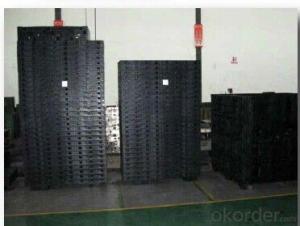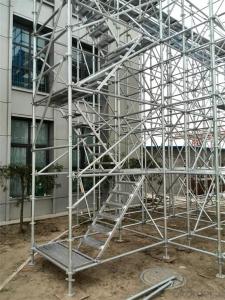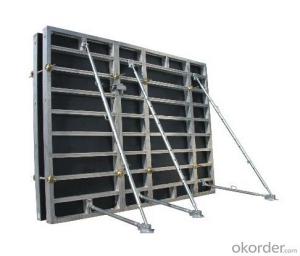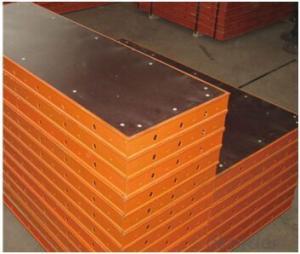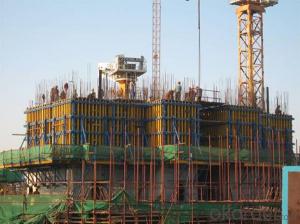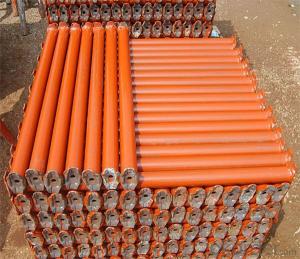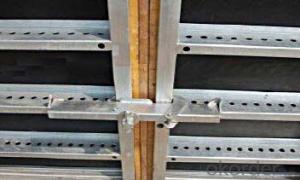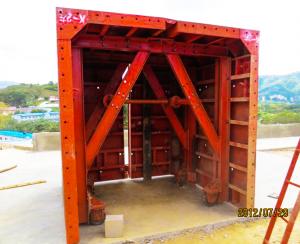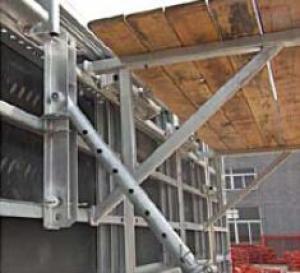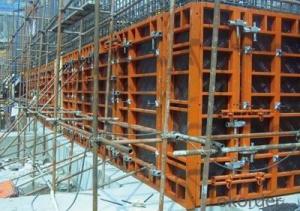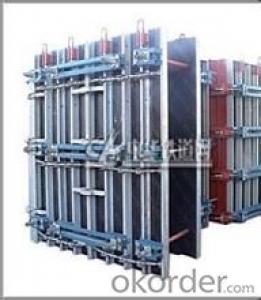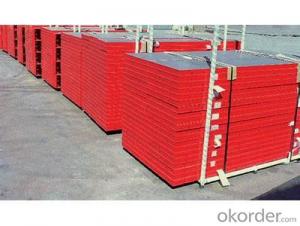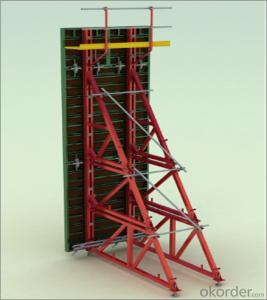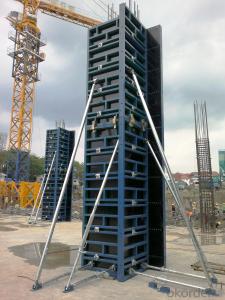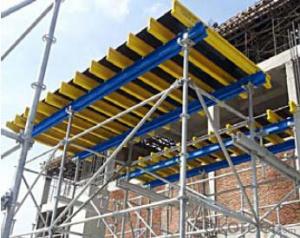Steel-frame Formwork
- Loading Port:
- XINGANG
- Payment Terms:
- TT or LC
- Min Order Qty:
- 55 Cubic Meter/Cubic Meters m.t.
- Supply Capability:
- 5000 Cubic Meter/Cubic Meters per Month m.t./month
OKorder Service Pledge
OKorder Financial Service
You Might Also Like
Quick Details of Steel-frame Formwork
Type: Plywoods
Place of Origin: China (Mainland)
Brand Name: CMAX
Usage: Outdoor
Grade: First-Class
Main Material: Poplar
Formaldehyde Emission Standards: E1
Plywood Type: 13-Ply Boards
Film: black,brown,red,anti-slip
Core: poplar,hardwood,eucalyptus,combi,birch
Glue: melamine WBP,phenolic
WBP Size: 1220*2440mm,1250*2500mm
Thickness: 9mm,12mm,15mm,18mm,21mm
Pressing: 1 time,2 times
Packaging & Delivery Steel-frame Formwork
Packaging Detail: inner with plastic bag,outer with carton board or thin plywood then fastened by steel belts with pallet
Delivery Detail: Within 15 days after receiving deposit or original L/C at sight
Specifications Steel-frame Formwork
1)Film:brown,black,red,anti-slip
2)Core:poplar,hardwood,combi,birch
3)Glue:melamine WBP,phenolic WBP
4)Useage:construction
Item | Film faced plywood/Marine plywood/Construction plywood | |
Face/Back | Brown film,Black Film,Red film,Anti-slip film | |
Core | Poplar,hardwood,Eucalyptus, Poplar, Birch | |
Glue | Melamine WBP glue,Phenolic WBP glue | |
Size(mm) | 1220×2440mm,1250×2500mm or as request | |
Thickness(mm) | 9mm,12mm,15mm,18mm,21mm | |
Moisture | 6-12% | |
Thickness tolerance | +/-0.5mm
| |
Packing | inner with plastic bag,outer with carton board or thin plywood then fastened by 4×6 lines steel belts with pallet | |
Quantity | 20’GP | 8 plts/22M3 |
40’GP | 16 plts/48M3 | |
40’HQ | 18 plts/55M3 | |
Useage | Using for making construction, industry | |
MOQ | 1×40'HQ | |
Payment Terms | TT:30% deposit, the balance agaist B/L copy L/C: irrevocable L/C at sight | |
Delievery Time | Within 15 days after receiving 30% deposit or original L/C at sight | |
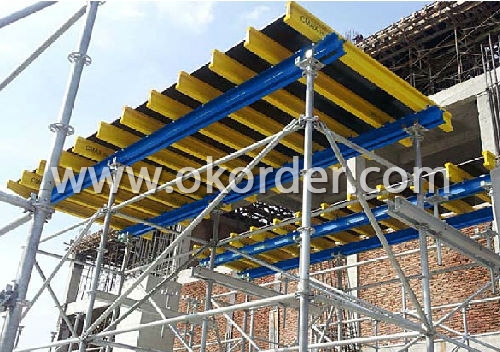
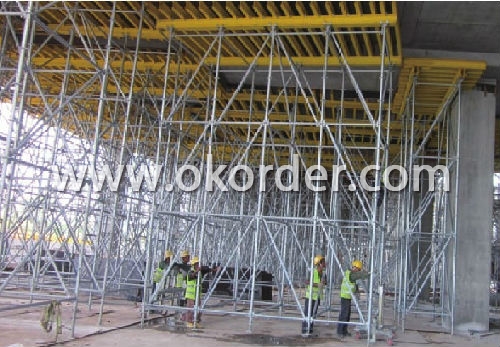
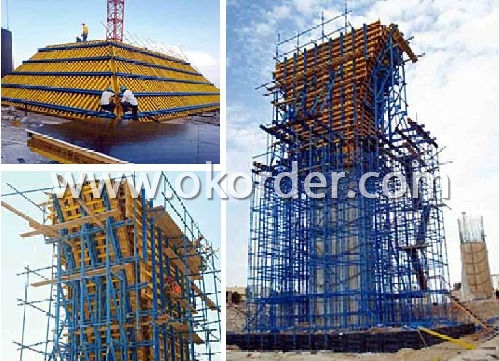
- Q: Can steel frame formwork be used for inclined concrete surfaces?
- Yes, steel frame formwork can be used for inclined concrete surfaces. Steel frame formwork is versatile and can be easily adjusted to different angles and slopes, making it suitable for constructing inclined concrete surfaces. The steel frames are strong and durable, providing stability and support during the concrete pouring and curing process. Additionally, steel formwork systems can be customized to fit specific project requirements, allowing for the creation of various inclined shapes and structures. Overall, steel frame formwork is an efficient and effective solution for constructing inclined concrete surfaces.
- Q: What are the different types of lifting inserts used with steel frame formwork?
- Steel frame formwork can be paired with several types of lifting inserts to facilitate the secure and efficient movement of the formwork. Among the available options is the threaded lifting insert. This insert incorporates a threaded rod that is embedded into the formwork. By attaching a lifting eye or hook to the threaded rod, individuals can easily lift and transport the formwork. Another alternative is the recessed lifting insert. This particular insert is embedded into the formwork and features a recessed area where a lifting eye or hook can be affixed. The recessed design effectively shields the lifting insert from potential damage during usage. Moreover, magnetic lifting inserts are also accessible. These inserts employ powerful magnets to securely hold the formwork in place while it is being lifted and moved. Their easy attachment and detachment from the formwork make them incredibly convenient and efficient. Certain lifting inserts additionally possess a swivel design, enabling a full 360-degree rotation of the formwork during lifting and transportation. This swivel capability ensures accurate and secure positioning of the formwork. In summary, the assortment of lifting inserts compatible with steel frame formwork offers various options for safely and effectively lifting and moving the formwork. The choice of which type to employ hinges on factors such as project-specific requirements, formwork weight, and the desired level of convenience and efficiency.
- Q: How does steel frame formwork handle concrete curing in hot conditions?
- Steel frame formwork is well-suited for handling concrete curing in hot conditions due to its excellent heat resistance and durability. The steel material has a high melting point, allowing it to withstand high temperatures without deforming or compromising its structural integrity. Additionally, steel frame formwork provides effective insulation, preventing rapid evaporation of moisture from the concrete mix during the curing process. This helps maintain the necessary moisture levels for proper hydration and strength development of the concrete, even in hot weather.
- Q: What are the different types of formwork ties used in steel frame formwork?
- There are several different types of formwork ties used in steel frame formwork, each with its own unique characteristics and advantages. Some of the most common types include: 1. Snap Ties: These are the most basic and commonly used formwork ties. They consist of two flat plates with a threaded rod in between. Snap ties are easy to use and provide solid connections between the formwork panels. 2. Wedge Ties: This type of tie consists of a flat plate that is inserted into a slot on the formwork panel. A wedge is then driven into the slot to secure the tie in place. Wedge ties are quick and easy to install and provide a strong connection. 3. Coil Ties: Coil ties are made from a continuous loop of wire that is threaded through the formwork panels. They are secured by twisting the ends together. Coil ties are versatile and can be used for a wide range of formwork applications. 4. She-Bolts: She-bolts are used in situations where it is not possible to use external ties. They consist of a threaded rod that is inserted into a hole drilled through the formwork panel. A washer and nut are used to secure the tie in place. 5. Cone Ties: Cone ties are similar to snap ties but have a conical shape on one end. This allows for easy removal of the tie after the concrete has cured. Cone ties are commonly used in situations where the formwork needs to be removed quickly. 6. Flat Ties: Flat ties are made from flat steel bars that are inserted through the formwork panels. They are secured using nuts and washers on both sides of the formwork. Flat ties provide a strong and secure connection. 7. Z Ties: Z ties are named for their Z-shaped profile. They are inserted into the formwork panels and secured using nuts and washers. Z ties are commonly used in situations where high load capacity and stability are required. These are just a few examples of the different types of formwork ties used in steel frame formwork. The choice of tie will depend on the specific requirements of the project, including the type of formwork being used, the load capacity required, and the desired ease of installation and removal.
- Q: What are the key considerations for selecting the appropriate steel frame formwork system for repetitive use?
- The key considerations for selecting the appropriate steel frame formwork system for repetitive use include durability, ease of assembly and dismantling, adaptability, cost-effectiveness, and compatibility with the construction project requirements. It is important to choose a system that can withstand multiple uses without compromising its structural integrity. The ease of assembly and dismantling is crucial for efficient construction processes. The formwork system should also be adaptable to different shapes and sizes of concrete structures. Cost-effectiveness is another important factor, considering the long-term savings achieved through repetitive use. Lastly, the selected system should be compatible with the specific requirements of the construction project, such as load-bearing capacity, safety features, and necessary accessories.
- Q: Does steel frame formwork require any specific curing temperature and duration?
- Steel frame formwork does not necessitate specific curing temperature and duration. Unlike concrete formwork, steel formwork is a resilient and robust material that does not require curing. Rather, it serves as a structural framework to bolster concrete during the pouring and hardening phases. While the curing temperature and duration for concrete are determined by the mix design and project specifications, they do not directly pertain to steel formwork.
- Q: Can steel frame formwork be used in projects with challenging ground conditions?
- Yes, steel frame formwork can be used in projects with challenging ground conditions. Steel frame formwork is known for its strength, durability, and stability, making it suitable for construction projects where the ground conditions may be unstable or challenging. The steel frame provides a robust structure that can withstand the pressures and forces exerted by the ground, ensuring the safety and stability of the formwork system. Additionally, steel frame formwork can be easily adjusted and modified to adapt to different ground conditions, allowing for efficient and effective construction in challenging environments. Overall, steel frame formwork is a reliable and versatile solution that can be utilized in projects with challenging ground conditions.
- Q: What are the different types of formwork hooks used in steel frame formwork systems?
- There are several different types of formwork hooks used in steel frame formwork systems, each with its own specific function and purpose. Some of the common types of formwork hooks include: 1. Wedge Hooks: These hooks are used to secure the formwork panels to the steel frame. They are typically inserted into slots on the frame and tightened using a wedge, providing a secure connection between the panel and the frame. 2. Flat Hooks: Flat hooks are used to connect formwork panels together horizontally. They have a flat design with a hook at one end, which allows them to be easily inserted into slots on the panels and locked in place. 3. Angle Hooks: Angle hooks are similar to flat hooks, but they have a bent or angled design. They are used to connect formwork panels together at corners or angles, providing a strong and stable connection. 4. Brace Hooks: Brace hooks are used to secure diagonal braces to the formwork system. They are typically inserted into slots on the frame and tightened using a wedge or a locking mechanism, ensuring the braces are securely attached to the frame. 5. Connecting Hooks: Connecting hooks are used to join two or more formwork frames together vertically. They are inserted into slots on the frames and tightened using a wedge or a locking mechanism, creating a sturdy connection between the frames. 6. Lifting Hooks: Lifting hooks are used to lift and move the formwork panels or frames. They are typically attached to the top or sides of the panels and provide a secure point for lifting with a crane or other lifting equipment. These are just a few examples of the different types of formwork hooks used in steel frame formwork systems. The specific type of hook used will depend on the design and requirements of the formwork system, as well as the specific application and project needs.
- Q: Are there any specific considerations for using steel frame formwork in earthquake-prone areas?
- There are specific factors to take into account when using steel frame formwork in earthquake-prone areas. To begin with, it is crucial to ensure that the steel frame formwork is designed and constructed in accordance with the seismic design requirements of the specific area. This entails considering variables such as the anticipated seismic activity level, soil conditions, and prevailing building codes and regulations. The steel frame formwork should possess sufficient strength and rigidity to withstand the seismic forces that may be exerted during an earthquake. This may necessitate the use of thicker steel sections, reinforcement, or additional bracing to enhance the structural integrity and stability of the formwork system. In earthquake-prone areas, establishing a secure connection between the steel frame formwork and the supporting structure is also of utmost importance. This can be achieved through appropriate anchorage and tie-down systems that are designed to resist the lateral forces generated by an earthquake. Proper attention should be given to the detailing and installation of these connections to ensure their effectiveness. Furthermore, it is advisable to utilize high-quality steel and ensure the proper maintenance and inspection of the steel frame formwork. Steel with high tensile strength and good ductility can offer better resistance to the dynamic forces experienced during an earthquake. Regular inspection and maintenance can aid in identifying any potential issues or damage, thereby enabling timely repairs or replacements to preserve the formwork's integrity. Lastly, the safety of workers during the construction process in earthquake-prone areas must be taken into consideration. This may involve implementing additional safety measures, such as providing adequate training on earthquake response and evacuation procedures, ensuring the availability of safe zones during seismic events, and utilizing protective equipment to minimize the risk of injuries. Overall, the use of steel frame formwork in earthquake-prone areas necessitates careful attention to design, construction, connection, material quality, maintenance, and worker safety. It is essential to consult experienced engineers and adhere to local building codes and regulations to ensure the safety and stability of construction in such areas.
- Q: Are there any specific considerations for using steel frame formwork in projects with corrosive environments?
- Corrosive environments require specific considerations when using steel frame formwork. Steel is susceptible to corrosion when exposed to moisture, oxygen, and chemicals. In such environments, the risk of corrosion-related damage or deterioration to steel formwork is higher. To address corrosion, various measures should be taken when utilizing steel formwork in corrosive environments. The initial consideration is selecting the appropriate steel type for the formwork. Stainless steel or galvanized steel are commonly employed in these settings due to their corrosion resistance. These types of steel possess a protective layer that impedes or slows down the corrosion process. Furthermore, it is crucial to employ proper waterproofing and surface protection techniques to minimize the steel frame formwork's exposure to corrosive elements. The application of suitable coatings, such as epoxy or polyurethane coatings, can provide an additional layer of defense against corrosion. Regular inspection and maintenance of the formwork are also essential to promptly identify any indications of corrosion and take necessary actions to prevent further damage. It is important to note that in highly corrosive environments, even with the use of corrosion-resistant materials and protective measures, the lifespan of steel formwork may be reduced. Therefore, it is advisable to evaluate alternative formwork materials, such as fiberglass or aluminum, which may offer superior resistance to corrosion in certain situations. In conclusion, when working with steel frame formwork in projects involving corrosive environments, it is essential to consider the steel type, implement appropriate protective measures, and conduct regular maintenance to ensure the formwork's longevity and performance.
1. Manufacturer Overview
| Location | Beijing, China |
| Year Established | 1995 |
| Annual Output Value | US$ 5 Million - US$ 6 Million |
| Main Markets | China; United States; Britain; Japan; Germany; Israel |
| Company Certifications | ISO 9001:2000;GBT 19001:2000 |
2. Manufacturer Certificates
| a) Certification Name | |
| Range | |
| Reference | |
| Validity Period |
3. Manufacturer Capability
| a) Trade Capacity | |
| Nearest Port | Xingnang |
| Export Percentage | |
| No.of Employees in Trade Department | 5 to 10 |
| Language Spoken: | Chinese; English |
| b) Factory Information | |
| Factory Size: | Above 6600 square meters |
| No. of Production Lines | Above 10 |
| Contract Manufacturing | Design Service Offered |
| Product Price Range | Average |
Send your message to us
Steel-frame Formwork
- Loading Port:
- XINGANG
- Payment Terms:
- TT or LC
- Min Order Qty:
- 55 Cubic Meter/Cubic Meters m.t.
- Supply Capability:
- 5000 Cubic Meter/Cubic Meters per Month m.t./month
OKorder Service Pledge
OKorder Financial Service
Similar products
Hot products
Hot Searches
Related keywords







